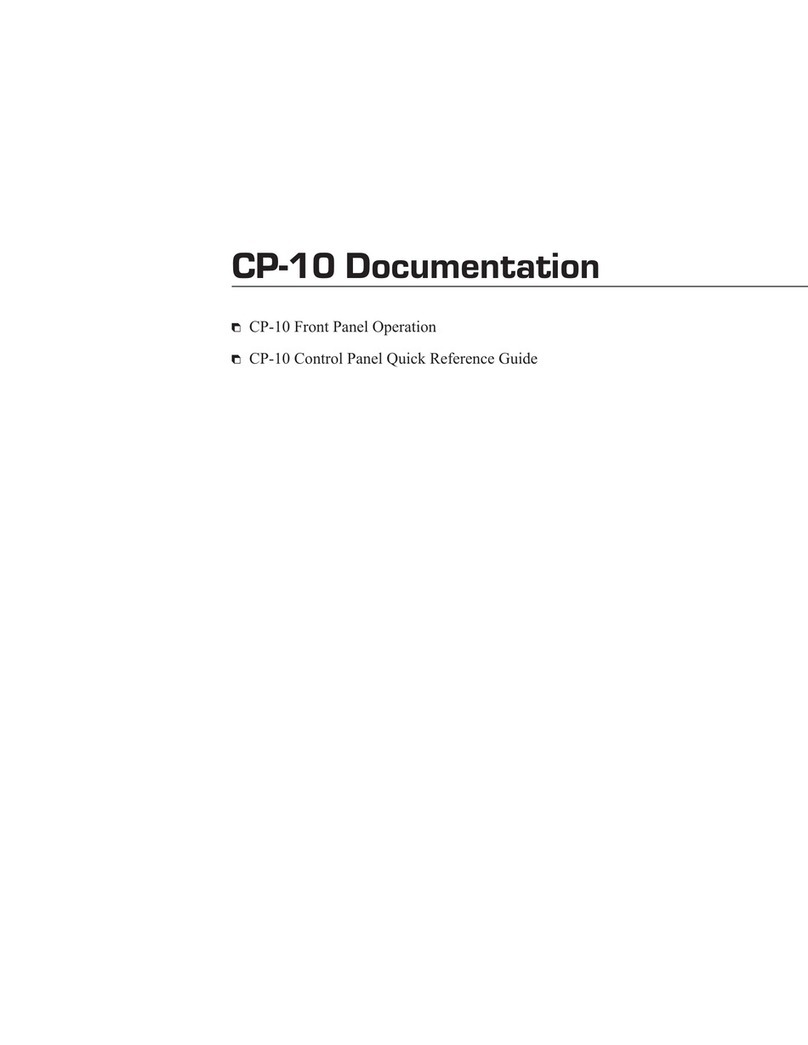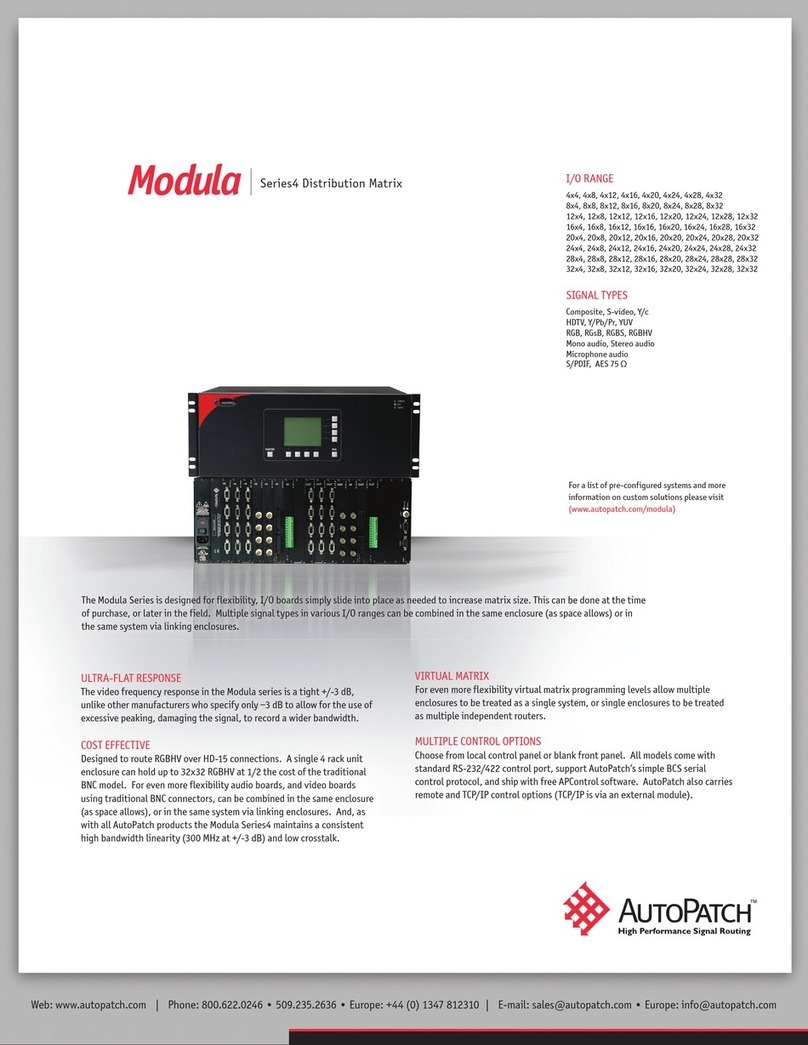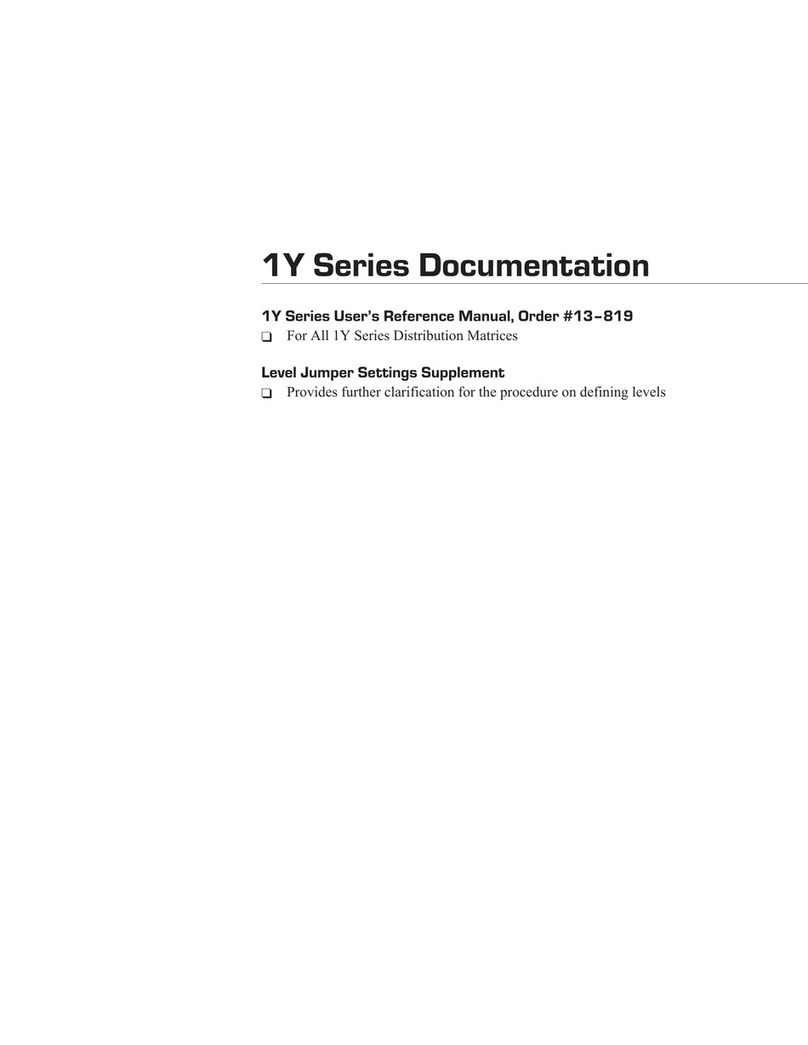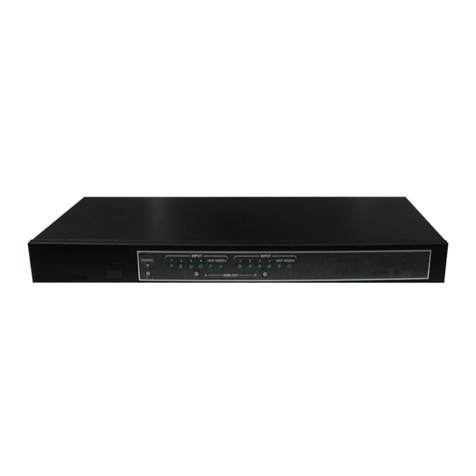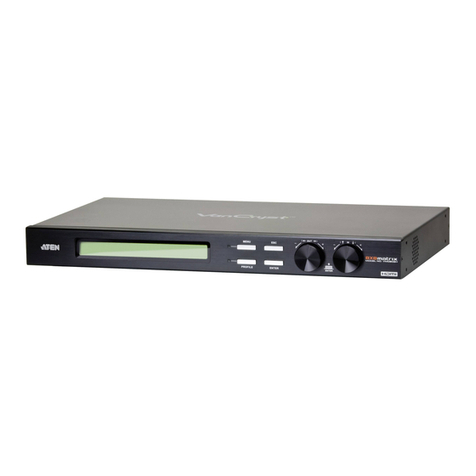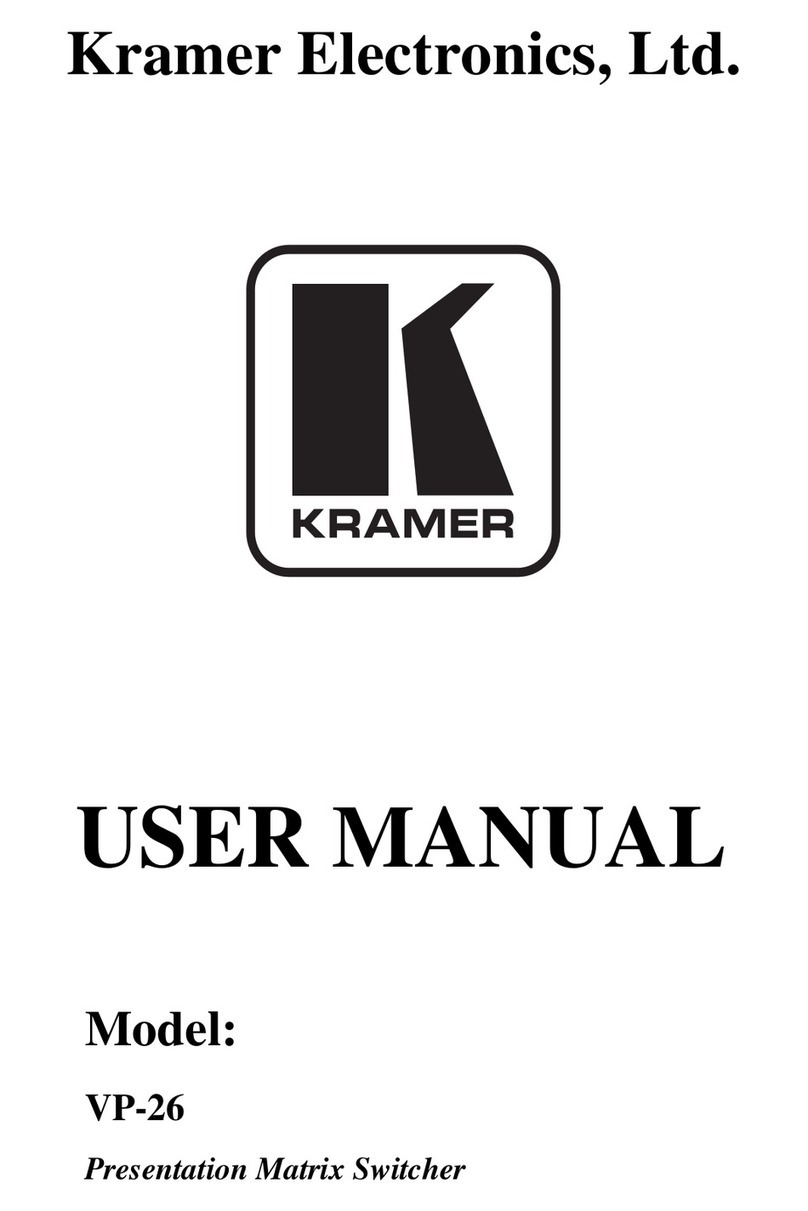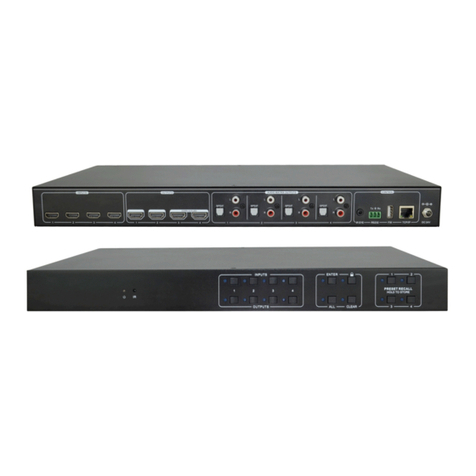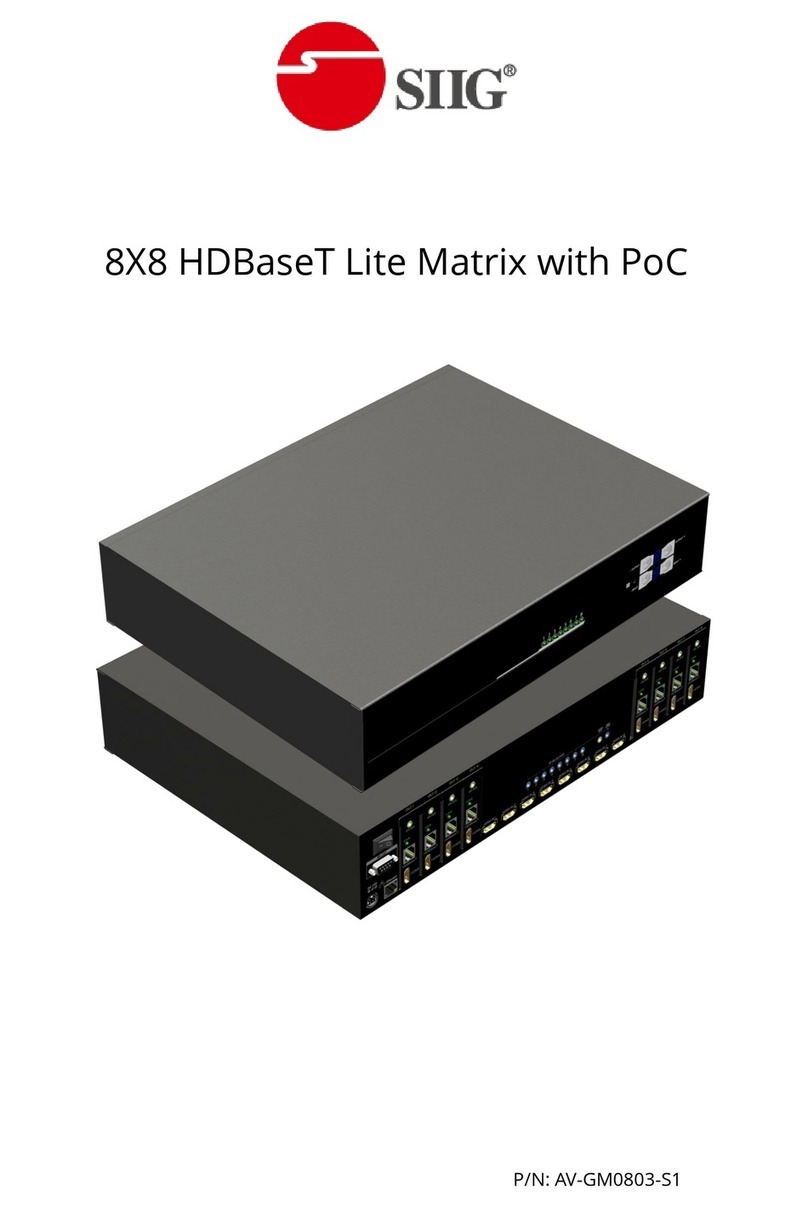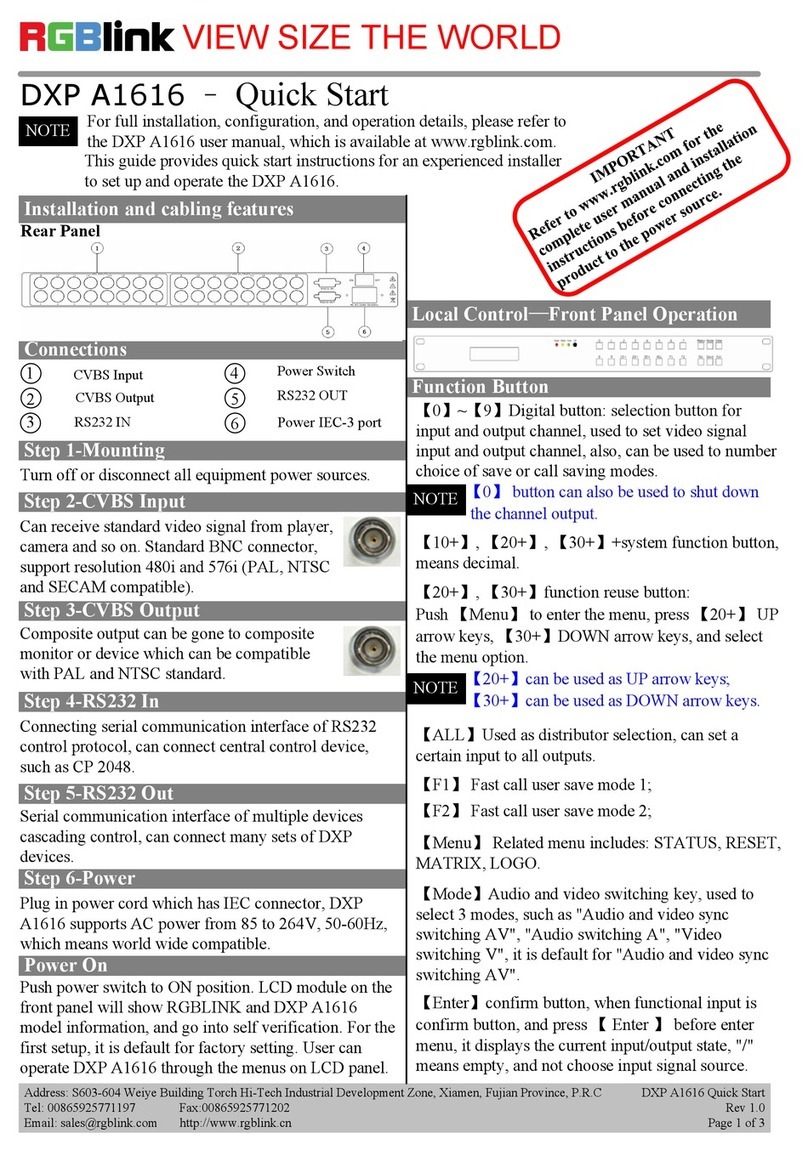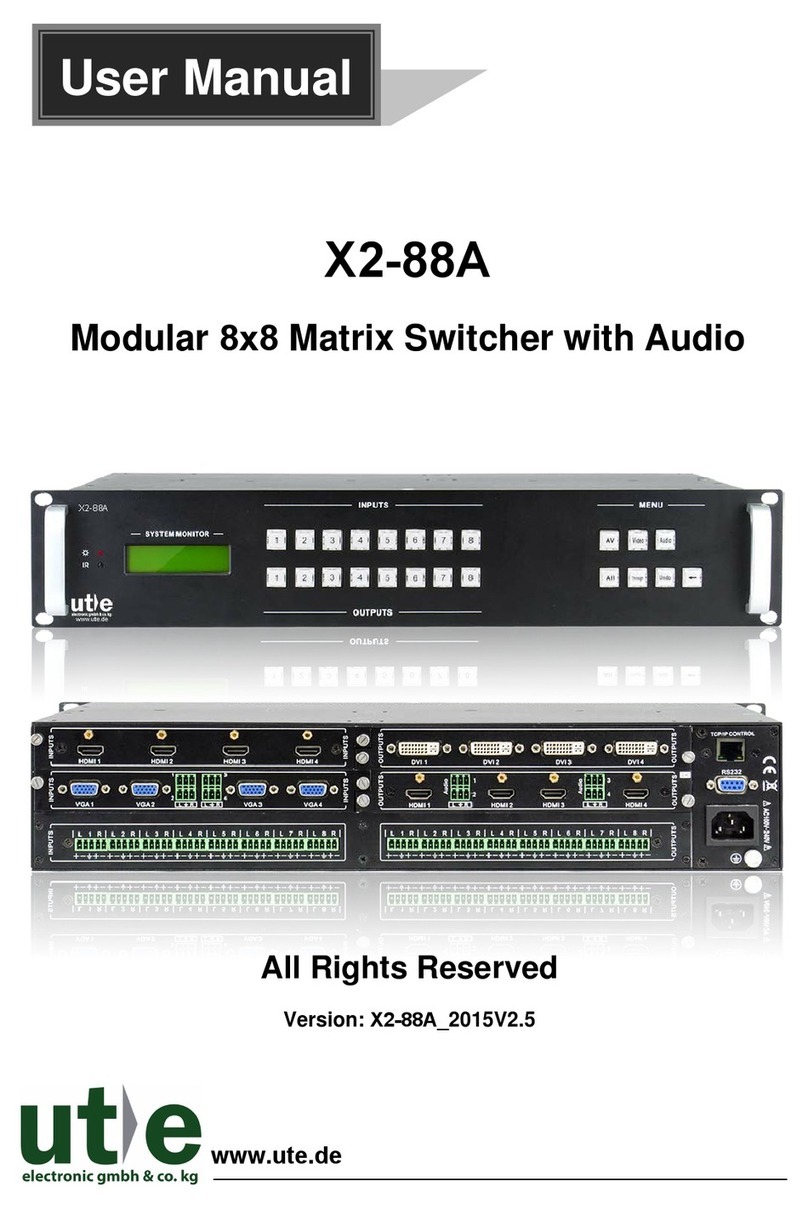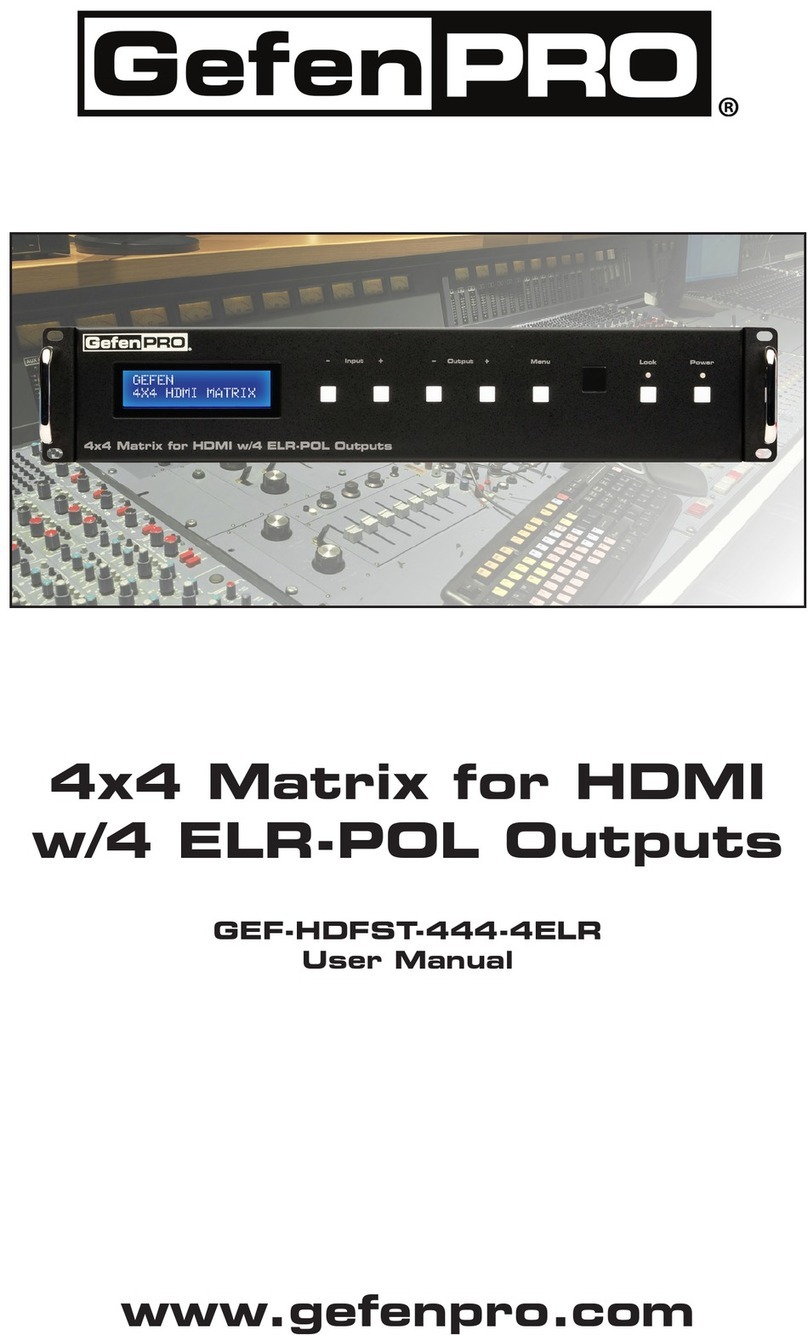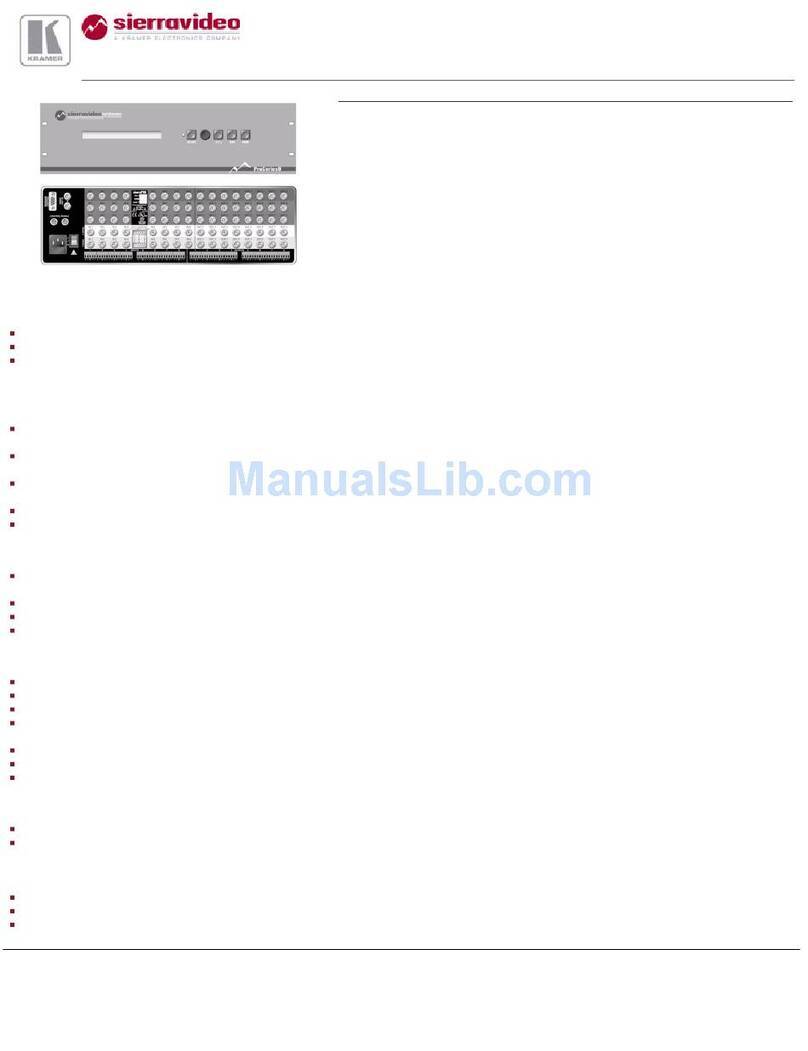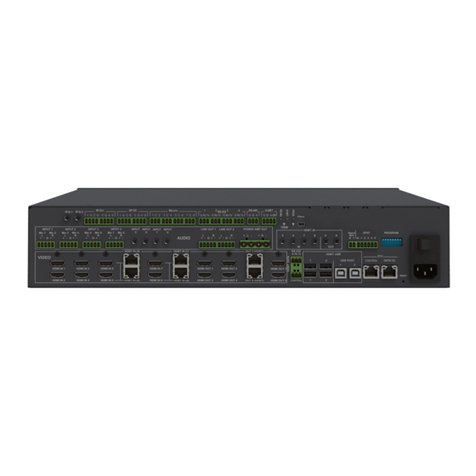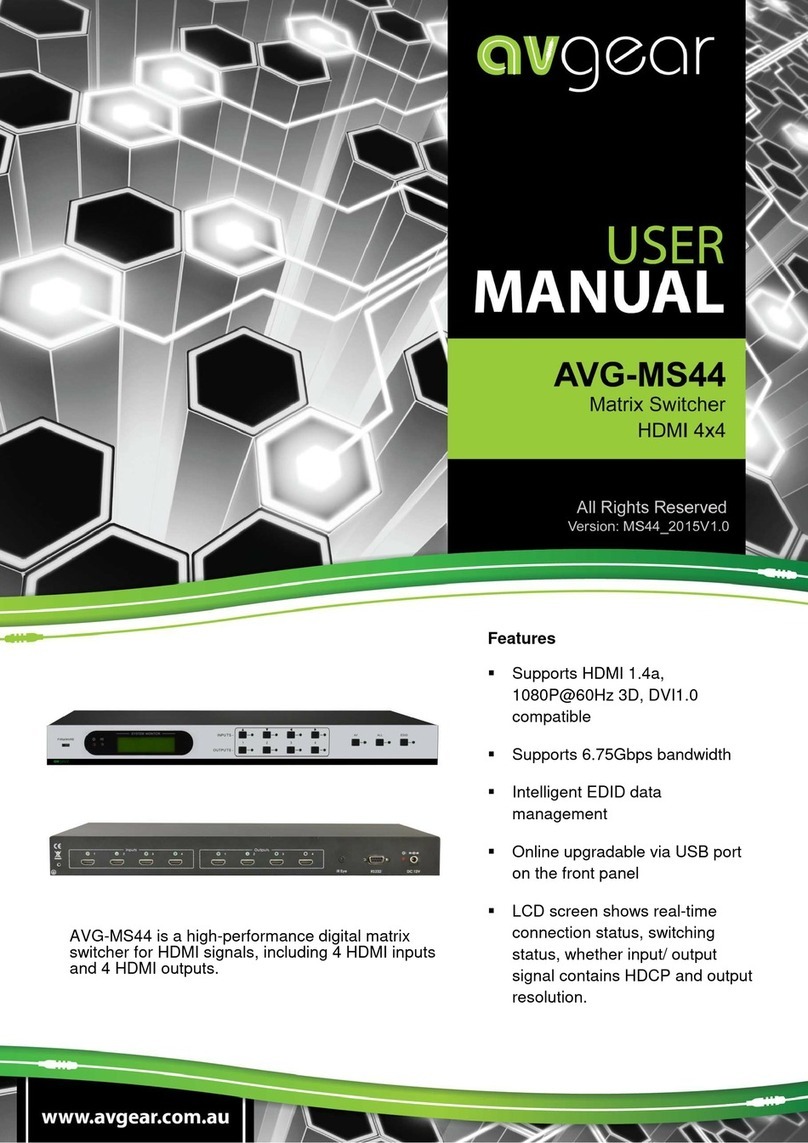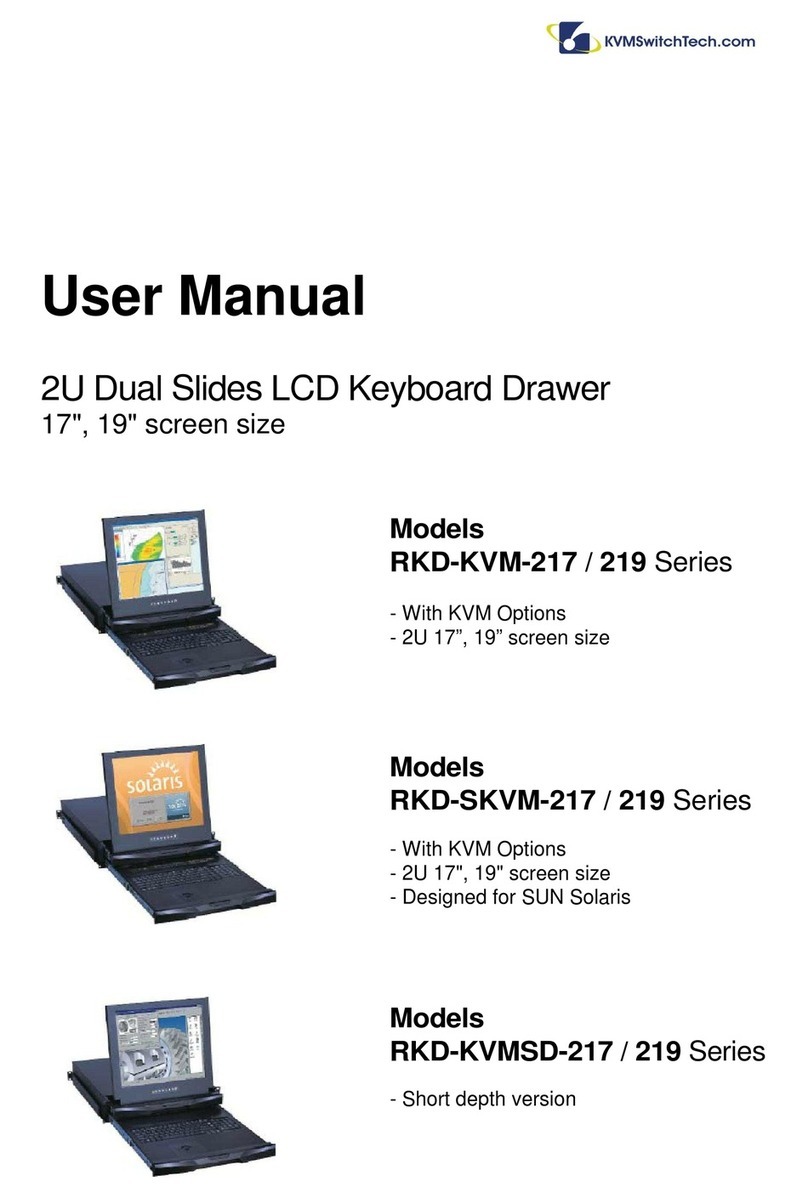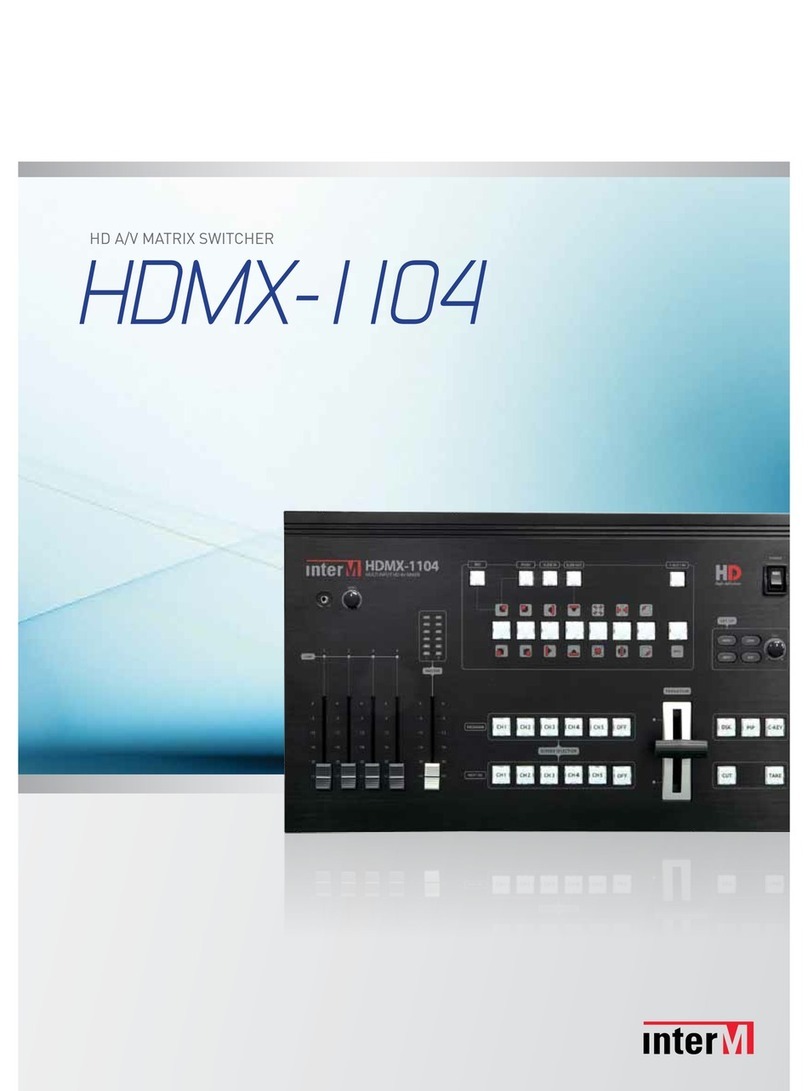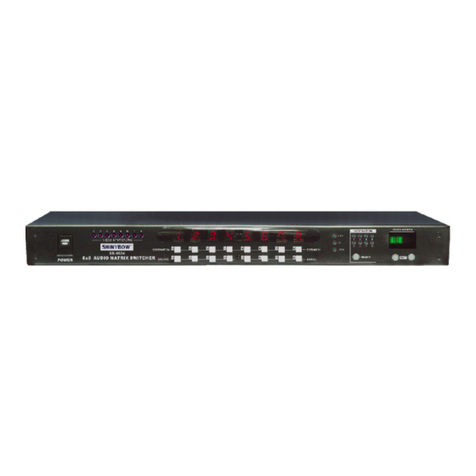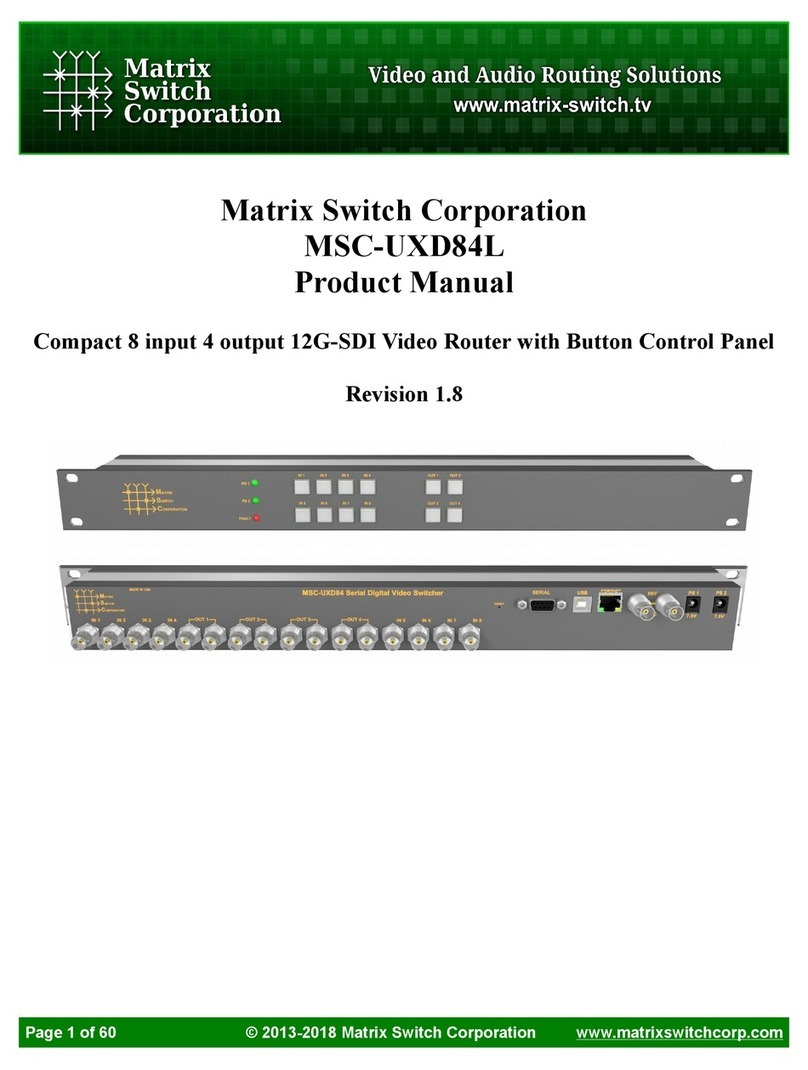AutoPatch 8Y-XL Assembly instructions

8Y-3000 Documentation Set
q8Y-3000 New Features
q8Y-3000 Installation and Setup Guide
q8Y-3000 User’s Operation Manual

8Y-3000 New Features
This manual contains information for the 8Y-3000 Distribution Matrix, an
advanced 8Y-XL system with the following additional features:
q32-bit processor
qLink to other AutoPatch products with an XNNet network compatible
interface
qLink to a larger line of XNNet AutoPatch control accessories
– Next Generation SBCs (with real-time status update)
– SDU
– CP-32
– CP-20
–CP-10
– Precis Remote Panel
qControllable via Ethernet, Neuron, RS-232/RS-422, and a variety of
XNNet-based control panels
– 10 Base-2 Ethernet interface
– Neuron Control network @ 76 Kbps, free topology
– Software selectable RS-232 or RS-422
– Serial port BAUD rate up to 57600
– Serial port Hardware/Software Handshaking
qNew, more powerful, virtual matrix structure and easy configuration
via XNConnect software
qIndividual crosspoint disconnect capability
qField upgradeable software
qLiteral switch does not invalidate status
qPreset request does not invalidate status
Note: The 8Y-3000 processor does not link and communicate with older
8Y-XL processors.

8Y-XL
Installation
andSetup
Guide
VersionA0
VersionB0905197

CAUTION
To avoid ESD (Electrostatic Discharge) damage to sensitive components, make
sure you are properly grounded before touching any internal materials.
When working with any equipment manufactured with electronic devices,
proper ESD grounding procedures must be followed to ensure people, products,
and tools are as free of static charges as possible. Grounding straps, conductive
smocks, and conductive work mats are specifically designed for this purpose.
Anyone performing field maintenance on AutoPatch equipment should utilize an
appropriate ESD field service kit complete with at least a dissipative work mat
with a ground cord and a UL listed adjustable wrist strap with another ground
cord. These items should not be manufactured locally, since they are generally
composed of highly resistive conductive materials to safely drain static charges,
without increasing an electrocution risk in the event of an accident. ESD
protective equipment can be obtained from 3M™, Desco®, Richmond
Technology®, Plastic Systems®, and other such vendors.
Installation and Setup Guide

Important Safety Information
and Instructions
When using and installing your AutoPatch product, adhere to the following basic safety
precautions. For more information about operating, installing, or servicing your
AutoPatch product see your product documentation.
äRead and understand all instructions before using and installing AutoPatch products.
äUse the correct voltage range for your AutoPatch product.
äThere are no user serviceable parts inside an AutoPatch product; service should only
be done by qualified personnel.
äIf you see smoke or smell a strange odor coming from your AutoPatch product, turn
it off immediately and call AutoAssist.
äTurn off and unplug an enclosure before adding or removing boards, unless otherwise
specified in that product’s documentation.
äTo avoid shock or potential ESD (Electrostatic Discharge) damage to equipment,
make sure you are properly grounded before touching components inside an
AutoPatch product.
äFor products with multiple power supplies in each unit, make sure all power supplies
are turned on simultaneously.
äUse surge protectors and/or AC line conditioners when powering AutoPatch
products.
äOnly use a fuse(s) with the correct fuse rating in your enclosure.
äMake sure the power outlet is close to the product and easily accessible.
äMake sure the product is on or attached to a stable surface.
äTurn off equipment before linking pieces together, unless otherwise specified in that
product’s documentation.
äFor safety and signal integrity, use a grounded external power source and a grounded
power connector.
Installation and Setup Guide

Information et directives
de sécurité importantes
Veuillez vous conformer aux directives de sécurité ci-dessous lorsque vous installez et
utilisez votre appareil AutoPatch. Pour de plus amples renseignements au sujet de
l’installation, du fonctionnement ou de la réparation de votre appareil AutoPatch, veuillez
consulter la documentation accompagnant l’appareil.
äLisez attentivement toutes les directives avant d’installer et d’utiliser les appareils
AutoPatch.
äLe voltage doit être approprié à l’appareil AutoPatch.
äLes appareils AutoPatch ne contiennent aucune pièce réparable par l’usager; la
réparation ne doit être effectuée que par du personnel qualifié.
äSi de la fumée ou une odeur étrange se dégagent d’un appareil AutoPatch, fermez-le
immédiatement et appelez le Service de soutien technique (AutoAssist).
äFermez et débranchez le boîtier avant d’ajouter ou d’enlever des plaquettes, à moins
d’indication contraire fournie dans la documentation du appareil.
äPour éviter les chocs ou les dommages éventuels causés à l’équipement par une
décharge électrostatique, veillez à ce le dispositif oit bien relié à la terre avant de
toucher les composantes se trouvant à l’intérieur d’un appareil AutoPatch.
äVeillez à ce que tous les blocs d’alimentation des appareils dotés de blocs
d’alimentation multiples dans chaque unité soient allumés simultanément.
äServez-vous de protecteurs de surtension ou de conditionneurs de lignes à courant
alternatif lorsque vous mettez les appareils AutoPatch sous tension.
äPlacez uniquement des fusibles de calibre exact dans les boîtiers.
äVeillez à ce que la prise de courant soit proche de l’appareil et facile d’accès.
äVeillez à ce que votre appareil AutoPatch soit installé sur une surface stable ou qu’il
y soit fermement maintenu.
äFermez toutes les composantes de l’équipement avant de relier des pièces, à moins
d’indication contraire fournie dans la documentation de l’appareil.
äPar mesure de sécurité et pour la qualité des signaux, servez-vous d’une source
d’alimentation externe mise à la terre et d’un connect d’alimentation mis à la terre.
Installation and Setup Guide

Notices
AutoPatch©2001, all rights reserved. No part of this publication may be reproduced,
stored in a retrieval system, or transmitted, in any form or by any means, electronic,
mechanical, photocopying, recording, or otherwise, without the prior written permission
of AutoPatch. Copyright protection claimed extends to AutoPatch hardware and software
and includes all forms and matters copyrightable material and information now allowed
by statutory or judicial law or here in after granted, including without limitation, material
generated from the software programs which are displayed on the screen such as icons,
screen display looks, etc. Reproduction or disassembly of embodied computer programs
or algorithms is expressly prohibited.
No patent liability is assumed with respect to the use of information contained herein.
While every precaution has been taken in the preparation of this publication, AutoPatch
assumes no responsibility for error or omissions. No liability is assumed for damages
resulting from the use of the information contained herein.
Further, this publication and features described herein are subject to change without
notice. The United States Federal Communications Commission (in 47CFR 15.838) has
specified that the following notice be brought to the attention of the users of this product.
Federal Communication Commission Radio Frequency Interference Statement:
“This equipment generates and uses radio frequency energy and if not installed and used
properly, that is, in strict accordance with the manufacturers instructions, may cause
interference to radio and television reception. It has been type-tested and found to
comply with the limits for a Class B computing device in accordance with the
specifications in Subpart J of Part 15 of FCC Rules, which are designed to provide
reasonable protection against such interference in a residential installation. However
there is no guarantee that interference will not occur in a particular installation. If this
equipment causes interference to radio or television reception, which can be determined
by turning the equipment off and on, the user is encouraged to try to correct the
interference by one or more of the following measures:
äReorient the receiving antenna
äRelocate the matrix with respect to the receiver
äMove the matrix away from the receiver
äPlug the matrix into a different outlet so that computer and receiver are on different
branch circuits
Installation and Setup Guide

If necessary, the user should consult the dealer or an experienced radio/television
technician for additional suggestions. The user may find the booklet, How to Identify and
Resolve Radio-TV Interference Problems, prepared by the Federal Communications
Commission to be helpful.”
This booklet is available from the U.S. Government Printing Office, Washington, D.C.
20402, Stock N. 004-000-00345-4.
8Y-XL™,X
NNet™, and XNConnect™are trademarks of XNTechnologies, Inc.
Use shielded cables. To comply with FCC Class B requirement, all external data
interface cables and adapters must be shielded.
MS-DOS, Windows, and Windows95 are registered trademarks of Microsoft
Corporation.
3M, Desco, Richmond Technology, and Plastic Systems are all registered trademarks.
Neuron®and LonTalk®are registered trademarks of Echelon.
Installation and Setup Guide

AutoPatch
Statement of Warranty
AutoPatch, a division of XNTechnologies, Inc., Cheney, Washington,
warrantees that the products manufactured by AutoPatch will be free of defects
in materials and workmanship for the lifetime of the product, subject to the
following terms and conditions.
Terms and Conditions
1. AutoPatch products are under warranty for a period of five (5) years
following the original sales invoice date. The warranty period may be
extended to the life of the product provided the warranty card is filled out
and returned to AutoPatch. TO VALIDATE THE LIFETIME
WARRANTY: THE AutoPatch WARRANTY CARD MUST BE FILLED
OUT BY THE DEALER AND RECEIVED BY AutoPatch WITHIN
THIRTY (30) DAYS OF THE INSTALLATION OF EQUIPMENT BUT
NO LATER THAN ONE (1) YEAR FROM THE ORIGINAL SALES
INVOICE DATE. A warranty certificate will be returned to the dealer to
verify the warranty period.
2. This Limited Lifetime warranty covers AutoPatch products shipped on or
after October 1, 1997. The Limited Lifetime warranty applies to products
in the original installation only. If the product is moved to a different
installation, the Limited Lifetime warranty will no longer apply and the
product warranty will revert to the original warranty which covers a period
of five (5) years following the original sales invoice date.
3. The product lifetime is defined as the period of time from the original sales
invoice date to ten (10) years after AutoPatch ceases manufacturing the
product model.
4. Warranty repairs are accomplished by returning the subassembly to
AutoPatch for repair. If conditions do not permit this procedure, AutoPatch
will invoice new or reconditioned (at AutoPatch’s option) replacement parts
and ship them to the dealer or to the customer if so directed by written order
from the dealer. In that case the replacement will be billed to the customer
and the customer may return the failed subassembly within 30 days for
credit. See “AutoPatch Returns Policy” in this manual for replacement
policies and procedures.
Installation and Setup Guide
Warranty

5. AutoPatch’s liability and Buyer’s remedies under this warranty shall
be limited solely to repair, replacement, or credit, at AutoPatch’s
option.
6. The AutoPatch warranty does not apply to any AutoPatch product that has
been modified, repaired by an unauthorized agent, or improperly installed,
used, or maintained. AutoPatch shall not be liable under any circumstances
for consequential or incidental damages including, but not limited to, labor
costs or loss of profits arising in connection with the use of or inability to
use AutoPatch products.
7. AutoPatch will not be responsible for items damaged during shipment to or
from AutoPatch. The shipping carrier is responsible for items damaged
during shipment.
8. This warranty is exclusive and in lieu of any other warranty, expressed or
implied, including but not limited to any implied merchantability or fitness
for a particular purpose. The terms of this warranty are governed by the
laws of the state of Washington; certain other states restrict warranty
limitations. You may have rights that are not defined herein.
9. This warranty may not be modified except in writing by an authorized
AutoPatch officer.
Installation and Setup Guide
Warranty

Contents
Welcome
Installer’s Product Notes ........................................ii
Meet the Manual...............................................iii
Terms to Know ................................................iv
Technical Support ..............................................v
Chapter 1 – Unpacking the 8Y-XL
Front of the Enclosure ........................................1-2
CP-10 Control Panel......................................1-3
Rear of the Enclosure ........................................1-6
Chapter 2 – Placing the Enclosure(s)
Chapter 3 – Linking Enclosures
Chapter 4 – Attaching Inputs and Outputs
Attaching Input and Output Cables .............................4-2
Paralleling Inputs.............................................4-4
Chapter 5 – Attaching an External Controller
Chapter 6 – Applying Power and the Startup Sequence
Applying Power ..............................................6-2
Startup from the CP-10 Control Panel..........................6-2
Startup from a Control Device .................................6-3
Chapter 7 – Executing a Test Switch
Executing a Test Switch Using CP-10 Control Panel..............7-2
Executing a Test Switch Using BCS Commands .................7-4
Installation and Setup Guide

Chapter 8 – Managing Configuration Files
Conceptual Overview .........................................8-2
Installing and Launching ......................................8-2
Panes, Views, and Dialog Boxes................................8-3
Opening and Downloading a Configuration File...................8-4
Modifying Configuration Files ..................................8-5
Configuring Local Presets.................................8-5
Modifying Groupings......................................8-8
Chapter 9 – Adjusting Gain
Chapter 10 – Adding Hardware
Adding Boards .............................................10-2
Input and Output Boards ................................10-2
Vertical Interval Timing Board ............................10-3
Adding Enclosures ..........................................10-5
Appendix A – AutoPatch Service and Returns Policy
Service......................................................A-1
Return Authorizations ....................................A-1
Claims for Shipping Damages .............................A-1
Replacement Policies and Procedures .........................A-2
Special Notice ...............................................A-3
Appendix B – Product Specifications
General .....................................................B-1
Analog Audio ................................................B-2
Standard Audio Boards ...................................B-2
Analog Video ................................................B-3
Standard Video Boards ...................................B-3
Wideband Video Boards ..................................B-4
Ultra-wideband Video Boards..............................B-5
Appendix C – BCS (Basic Control Structure) Commands
Glossary
Index
Installation and Setup Guide

Welcome
Welcome to the 8Y-XL Installation and Setup Guide. This book is the
first part of a three document set:
Installation and Setup Guide – compiled for the technician installing
the system.
User’s Operation Manual – created for the end-user who operates the
system.
Quick Reference Guide – a companion to the User’s Operation Manual.
The 8Y-XL Installation and Setup Guide is designed to provide the
installation technician with quick, easy-to-follow instructions for
installing an 8Y-XL and preparing it for operation.
The 8Y-XL User’s Operation Manual does not include any detailed
information about SBCs (Single Bus Controllers) for the 8Y-XL. Call
AutoAssist for more information about this controller type (see Technical
Support,p.v).
Installation and Setup Guide i
Welcome

Installer’s Product Notes
An 8Y-XL Distribution Matrix can stand alone or comprise a virtually
unlimited number of linked enclosures, including any other AutoPatch
products with an XNNet network compatible interface. Each 8Y-XL
enclosure can hold up to 8 input and 8 output boards and each board can
have up to 8 connectors, for a total capacity of 64 inputs and 64 outputs
per enclosure.
8Y-XL Distribution Matrices fit in a broad range of audio/video
environments and are controllable from a variety of sources, including a
CP-10 Control Panel, a CP-10 Remote Control Panel, any control device
that can send ASCII characters through an RS232 or RS422 serial cable,
a third party serial controller*, a PC, or a Single Bus Controller*.
Tools for Installation:
qA laptop computer with an RS232 or RS422 null modem cable
(communication with the 8Y-XL via a serial port for programming
and fault isolation)
qThe AutoPatch Configuration Software set (which includes copy of
the configuration file) shipped with the system
qThe full set of user documentation shipped with the system
*These control devices are not covered in this document.
ii Installation and Setup Guide
Welcome
Welcome

Meet the Manual
This manual contains 10 chapters and 3 appendices. The information in
this manual progresses from unpacking the 8Y-XL in Chapter 1 to BCS
(Basic Control Structure) commands in Appendix C. Use the following
chapter descriptions to guide you through the manual.
Title Description
Chapter 1
Unpacking the 8Y-XL
äItems included in shipping and unpacking tips
äDescription of the enclosure’s physical features
Chapter 2
Placing the Enclosure(s)
äList of tools needed for installation
äSteps for placing the enclosure(s)
Chapter 3
Linking Enclosures
äInformation on linking enclosures
Chapter 4
Attaching Inputs and Outputs
äDirections for attaching input and output cables
äDirections for paralleling inputs
Chapter 5
Attaching an External Controller
äDirections for attaching an external control
device to an enclosure
Chapter 6
Applying Power and
the Startup Sequence
äDirections for applying power
äStartup sequence from the CP-10 Control Panel
äStartup sequence from a serial control device
Chapter 7
Executing a Test Switch
äDirections for executing a test switch from the
CP-10 Control Panel
äDirections for executing and disconnecting a
test switch using BCS commands
Chapter 8
Managing Configuration Files
äConceptual overview and screen description of
XNConnect
äDirections for installing and launching
XNConnect
äDirections for opening and downloading
configuration files
äDirections for modifying configuration files
Chapter 9
Adjusting Gain
äDirections for adjusting gain
Chapter 10
Adding Hardware
äDirections for adding boards and enclosures to
expand system switching capabilities
Appendix A
AutoPatch Service and
Returns Policy
äDetails regarding AutoPatch Service and
Returns policies
Appendix B
Product Specifications
äTechnical specifications and performance
information
Appendix C
BCS (Basic Control Structure)
Commands
äBCS characters, functions, and descriptions in
chart format
Glossary äDefinitions of terms as they are used in this
manual
Index äIndex of subjects by features and tasks
Installation and Setup Guide iii
Meet the Manual
Welcome

Terms to Know
Before jumping into the technical details of this manual, you should be
familiar with the following terms:
Basic Control Structure (BCS)
BCS is a set of alphanumeric characters that combine to form command
lines. Use BCS to control a system from any serial device that allows you
to enter characters, such as a PC (personal computer).
Configuration File
A configuration file is a text file containing system configuration
information referenced by each enclosure’s CPU during any type of
switch operation. If a system has multiple enclosures linked together,
configuration information uploaded to any 8Y-XL enclosure is
automatically shared with the rest of the linked enclosures in the system.
CP-10 Control Panel
The CP-10 Control Panel is attached to each enclosure and is designed
for system control of the 8Y-XL Distribution Matrix.
ESD
Electrostatic Discharge (ESD) refers to electrical charges (such as static
electricity) that can damage sensitive components inside an enclosure.
The graphic to the left of this definition precedes every procedure where
ESD damage could occur if you are not properly grounded and not
handling components correctly (see the Caution page inside the front
cover of this guide for more details about ESD).
Input and Output Connectors
Input and output connectors are on the rear of an enclosure. Input and
output signal cables attach to the input and output connectors. Standard
8Y-XL audio and data connectors are 3-position terminal block; video
and sync connectors are BNC.
Level
A level is a set of input and output signals that are grouped and,
therefore, switch together. In a configuration file, a level is referred to as
a “virtual matrix.”
iv Installation and Setup Guide
Welcome
Welcome

Signal
A signal can be analog audio, analog video, serial digital, sync
information, or other types. A signal (also called an input or output
signal) comprises of a set of connectors whose signals switch together,
such as an “RGB” signal. To route a specific input (source) signal to a
specific output (destination) device, the input and output signals must be
of the same signal type and share the same level designation.
Switch
A switch is an active connection between an input (source) signal and
one or more output (destination) devices.
XNConnect
XNConnect is graphical software program that displays your most recent
configuration and allows easy addition of local presets and modification
of other configuration information (see the XNConnect Help file for
assistance).
XNNet
XNNet is an internal communication protocol that requires software
driver support for Ethernet and Neuron®interfaces.
Technical Support
AutoPatch provides technical support 24 hours a day, 7 days a week
(except for U.S. holidays). Before calling with a question, please consult
the 8Y-XL documentation. If these manuals cannot fully answer your
question, have your serial number (located on the plate between the
input and output connectors on the rear of the enclosure) ready and call
your authorized AutoPatch dealer or call AutoPatch AutoAssist at: (toll
free for U.S. and Canada) 800-622-0246 or (international) 509-235-2636.
You can also reach us through our web site: www.autopatch.com,or
e-mail our AutoPatch Technical Support Specialists at:
Installation and Setup Guide v
Technical Support
Welcome

Unpacking the 8Y-XL
The 8Y-XL is shipped with one enclosure in each shipping box. Each
box contains one of each of the following items (invoices are sent
separately):
qPower cords (one per enclosure)
qEnclosure
The shipping boxes are marked as “Box #_of_,” where the first blank is
the box number and the second blank is the total number of boxes in the
shipment. Box #1 contains several additional items:
qPacking list
qInstallation and Setup Guide
qUser’s Operation Manual
qQuick Reference Guide (inside binder)
qAutoPatch 8Y-XL Connector and Groupings Guide
qAutoPatch Configuration Software set
qLink cable (included with multi-enclosure systems)
qOther enclosure products
Installation and Setup Guide 1-1
Unpacking

Unpacking Tips
qBefore fully unpacking the enclosure(s), examine the shipping
box(es) for any signs of damage. If a box is partially crushed or any
sides have been broken open, notify the shipping agency
immediately and contact your AutoPatch Salesperson or
Representative.
qOnce unpacking is complete, closely check the physical condition of
the enclosure(s).
qCollect all documentation and envelopes.
Note: AutoPatch is not responsible for damage caused by insufficient
packing during return shipment to the factory. Upon request, AutoPatch
will supply new shipping boxes at cost.
1.1 Front of the Enclosure
Enclosures are the structural basis of an 8Y-XL Distribution Matrix.
Since AutoPatch matrix switchers are custom-built for each installation,
factors such as control method, signal type, and potential switches affect
the appearance and weight of each enclosure.
An enclosure can have a blank front panel or a CP-10 Control Panel (a
front panel that is produced by AutoPatch and has an LCD screen and
keys for entering commands). Although a CP-10 Control Panel is
optional, we recommend one on at least one enclosure in the system for
system verification, redundant control, and troubleshooting. The CP-10
Control Panel can be attached or removed as needed.
1-2 Installation and Setup Guide
Unpacking the 8Y-XL
Unpacking

CP-10 Control Panel
A CP-10 Control Panel has 29 keys – 10 number keys for entering digits,
4 directional arrow keys, and 1 each of the following: Cancel, Take,
Status, Level, Change, Input, Output, Preset, Program, Backlight, Space,
Special, Undo, Comma, and Period (the last four are not implemented).
To use the CP-10 Control Panel, use the keys to choose commands and
values from the Command Screen.
To choose a command, push the key that corresponds with the one you
want to choose.
To select values for fields (such as Level, Source, Destination, and
Preset values), use the number keys.
Number Keys (0-9)
Use the number keys to enter digits when choosing front panel menu
items (instead of scrolling down the lists), entering input, output, and
local preset numbers, and entering digits for any other functions that may
require numbers.
Arrow Keys
Use the arrow keys to scroll left and right through long lists of outputs.
The arrow keys are required only when an arrow graphic is displayed on
the front panel’s LCD screen.
Installation and Setup Guide 1-3
Front of the Enclosure
Unpacking
SPECI AL PRESET PROGRAM BACKLI GHT UNDO
TAKE
CA N CEL
SPACE
123
6
54
789
INPUT OUTPUT
STATUS LEVEL CH AN GE
power
Front view of an 8Y-XL enclosure with a CP-10 Control Panel
LCD Screen
Arrow Keys
This manual suits for next models
1
Table of contents
Other AutoPatch Matrix Switcher manuals
